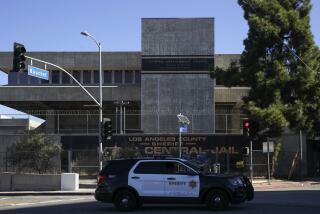This Boys Town Isn’t the One of Yesteryear : Children’s services: Emergency intervention and family counseling--not housing--will be emphasized at the residence for youths under construction at Wardlow Road and Pacific Avenue.
- Share via
LONG BEACH — The house being built in Long Beach will not be the Boys Town that Bob Sullivan remembers.
When “Sully” first arrived at Father Edward J. Flannigan’s sprawling home for boys outside Omaha, Neb., it was 1947 and regimentation was the key word in controlling youngsters.
Sullivan was 9 years old, and he did not like it. So he stole Flannigan’s new Chrysler and went to town.
“After they brought me back, Father Flannigan sat me down and asked me why I did it,” Sullivan remembers. “He was very nice about it, but stern. Two days later, I took a Chevy.”
Despite his early escapades, Sullivan stayed at Boys Town until he was 17. The 55-year-old tile contractor, who now lives in North Hollywood, was among dozens of Boys Town alumni who recently watched dignitaries break ground on a new home for wayward teen-agers and troubled children. It will be at Wardlow Road and Pacific Avenue in Long Beach.
They were witnessing a completely different era of Flannigan’s organization for orphaned and neglected boys--made famous by an Oscar-winning 1938 Spencer Tracy movie.
The Long Beach home, like nine others scattered around the country, will emphasize emergency intervention and family counseling rather than long-term residency, which was the rule on the Omaha farm.
Sixteen beds will be available for boys and girls--the old boys home went co-ed in 1979--in the house when it opens next spring, but few youths will stay more than two weeks. Instead, the center will concentrate on counseling and returning children to their families.
A more traditional Boys Town, containing longer-term residency for troubled teens, is planned on 70 acres in Trabuco Canyon in Orange County. The building of five ranch-style houses had been held up in court battles since 1989. But recently, a judge ruled in favor of Boys Town, and Michael Riley, executive director of Boys Town of Southern California, hopes to begin construction before the year’s end.
At the Long Beach house, educational testing and diagnosis, psychiatric counseling and help for children with problems in school also will be offered.
“I think the way Boys Town is now, it’s a lot better for kids,” said Steven Koi of Orange, a former resident of the Omaha home.
“It was real regimented before, kind of military-like. Now the setup is more like a family,” said the unemployed electronics technician.
The changes in Flannigan’s dream of a safe home for boys began taking shape in the early 1970s, said Father Val J. Peter, executive director of Boys Town.
The Roman Catholic priests who ran the town--which became an official municipality in 1936--saw more boys coming in with drug and alcohol addiction in the late 1960s. Their problems were more complex than Boys Town programs could deal with, Peter said.
Flannigan died in 1948, and in 1972 the home fell from public grace as newspapers reported that donations to the town were large, but the boys received very little. Donations dropped dramatically. For several years, the organization cut back on fund raising and built a center for the study of child behavior with money that had been stockpiled, Peter said.
Ed Welch remembers that time well. He was 17 and had lived in Boys Town with two of his brothers since he was 12, when his alcoholic parents could no longer care for them.
“I didn’t think we wanted for much,” said Welch, 36, now a director of business operations for Unisys Corp. in Santa Ana. “I remember seeing the stories, but they were blown out of proportion.”
Information packets handed out at the Long Beach ground-breaking ceremony last month included breakdowns of how donations are spent. In the competition for a shrinking pool of charity dollars, honesty is essential, Peter said.
Even with all the changes, Boys Town alumni who gathered said little could shake their faith in the organization that gave them safe harbor.
“Father Flannigan once said there was no such thing as a bad boy, but I think I pushed that definition to the edge,” said Koi, now 35. “Still, I don’t know where I’d be now if I hadn’t been to Boys Town.”
More to Read
Sign up for Essential California
The most important California stories and recommendations in your inbox every morning.
You may occasionally receive promotional content from the Los Angeles Times.













![Vista, California-Apri 2, 2025-Hours after undergoing dental surgery a 9-year-old girl was found unresponsive in her home, officials are investigating what caused her death. On March 18, Silvanna Moreno was placed under anesthesia for a dental surgery at Dreamtime Dentistry, a dental facility that "strive[s] to be the premier office for sedation dentistry in Vitsa, CA. (Google Maps)](https://ca-times.brightspotcdn.com/dims4/default/07a58b2/2147483647/strip/true/crop/2016x1344+29+0/resize/840x560!/quality/75/?url=https%3A%2F%2Fcalifornia-times-brightspot.s3.amazonaws.com%2F78%2Ffd%2F9bbf9b62489fa209f9c67df2e472%2Fla-me-dreamtime-dentist-01.jpg)